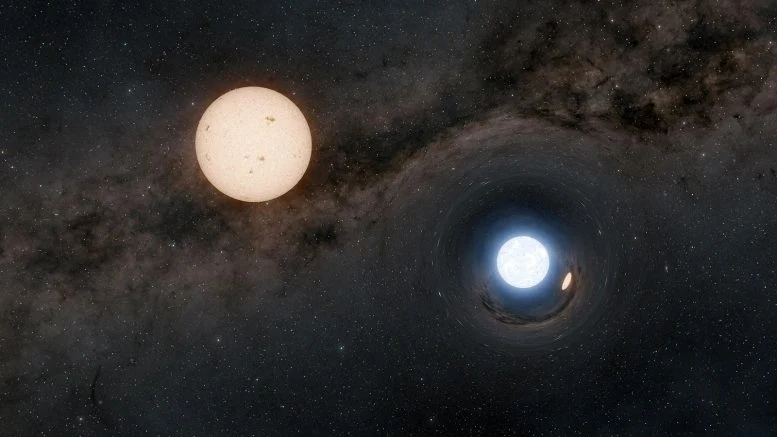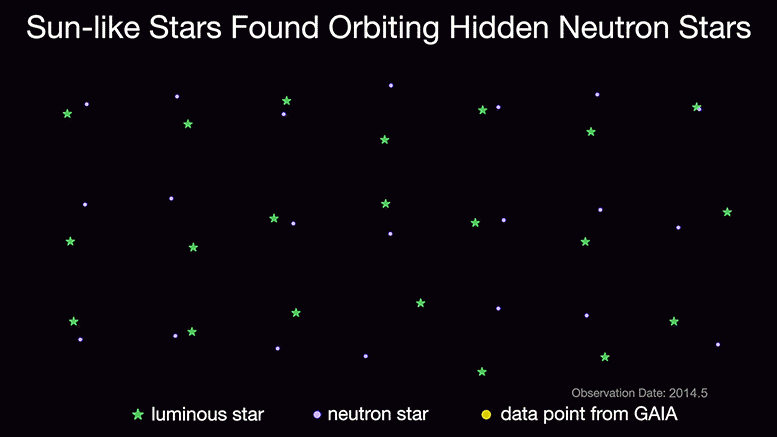New observations reveal neutron stars paired with stars like our Sun.
Most stars in our universe come in pairs. While our own Sun is a loner, stars like our Sun have similar stars orbiting them, and many other exotic pairings between stars and cosmic orbs pepper the universe. Black holes often are found orbiting with each other. One pairing that has proved quite rare is that between a Sun-like star and a type of dead star called a neutron star.
A team of astronomers has now found what appear to be 21 neutron stars orbiting in binary systems with stars much like our Sun. Neutron stars are the dense, burned-out cores of massive stars that exploded. Alone, they are very faint and usually can’t be detected directly. They are more massive than Sun-like stars, but the two objects orbit each other around a common center of mass. The neutron stars, as they orbit, tug on the Sun-like stars, causing their companions to shift back and forth in the sky. It was with the catching of these telltale wobbles, using the European Space Agency’s Gaia mission, that the astronomers were able to uncover a new population of dark neutron stars.
The role of Gaia in astrophysics research
“Gaia is sort of constantly scanning the sky and measuring wobbles of over a billion stars, so the odds are actually pretty good to find even very rare sorts of objects,” said El-Badry, an assistant professor of astronomy at Caltech and an adjunct scientist at the Max Planck Institute for Astronomy in Germany.
Also Read: How AI is used in Fingerprint Recognition?
A new study, which includes a global team of co-authors, published the discovery on July 15 in The Open Journal for Astrophysics. Follow-up ground-based observing campaigns used data from the W. M. Keck Observatory on Maunakea, Hawai’i; La Silla Observatory in Chile; and the Whipple Observatory in Arizona to follow up the Gaia observations that permitted learning more about the masses and orbits of the hidden neutron stars.

Destiny Distinctive Features of the New Neutron Star Systems
Whereas neutron stars have previously been detected in orbit around stars similar to our Sun, all those systems have been relatively compact. In those systems, with the neutron star and its companion star not far apart, the neutron star—because it’s more massive than a Sun-like star—can pull some material off its companion star. As that transferred material falls onto the neutron star, it heats up and radiates strongly at either X-ray or radio wavelengths, making the neutron star shine brightly. In contrast, the neutron stars in the new study are much farther from their companions—on the order of one to three times the distance between Earth and the Sun.
That means the newfound stellar corpses are too far from their companions to be siphoning material off them. They are instead quiescent and dark. “These are the first neutron stars discovered purely because of their gravitational effects,” El-Badry says.
The Mystery of Binary System Formation
The finding is somewhat a surprise because it is not clear how an exploded star ends up beside a star like our Sun.
“We still don’t have a complete model for how these binaries form,” El-Badry says. “In principle, the progenitor to the neutron star should have become huge and interacted with the solar-type star during its late-stage evolution.” The big star would have knocked the small star around — probably briefly engulfing it. Later still, the neutron star progenitor would have blown up in a supernova that, according to models, should have unbound the binary systems, sending neutron stars and Sun-like stars careening off in opposite directions.
“The discovery of these new systems shows that at least some binaries survive these cataclysmic processes even though models can not yet fully explain how,” he says.

Gaia’s Detection Capabilities and Future Research
Gaia was able to detect the unlikely companions because of their wide orbits and correspondingly long periods: it takes six months to three years for one of the Sun-like stars to circle a neutron star. “If the bodies are too close, the wobble will be too small to detect,” El-Badry says. “With Gaia, we are more sensitive to the wider orbits.” Gaia is also most sensitive to binaries that are relatively nearby. Most of the newly discovered systems are located within 3,000 light-years of Earth—a relatively small distance compared, for example, to the 100,000 light-year-diameter of the Milky Way Galaxy.
The new observations also indicate just how rare the pairings are. “We estimate that about one in a million solar-type stars is orbiting a neutron star in a wide orbit,” he said.
Expanding the Search Beyond Neutron Stars
Notably, El-Badry also searches for dark, quiescent black holes orbiting with Sun-like stars. He has so far identified two such quiet black holes in our galaxy from Gaia data. One is called Gaia BH1, the nearest known black hole to Earth, which is 1,600 light-years away.
“We do not know exactly how those black hole binaries formed either,” El-Badry says. “There are clearly gaps in our models for the evolution of binary stars. Finding more of these dark companions and comparing their population statistics to predictions of different models will help us piece together how they form.”
Reference: “A population of neutron star candidates in wide orbits from Gaia astrometry” by Kareem El-Badry, Hans-Walter Rix, David W. Latham, Sahar Shahaf, Tsevi Mazeh, Allyson Bieryla, Lars A. Buchhave, René Andrae, Natsuko Yamaguchi, Howard Isaacson, Andrew W. Howard, Alessandro Savino and Ilya V. Ilyin, 15 July 2024, The Open Journal of Astrophysics.
DOI: 10.33232/001c.121261
The paper was funded by the National Science Foundation, the European Research Council, and the Gordon and Betty Moore Foundation. Other Caltech authors include graduate student Natsuko Yamaguchi and Professor of Astronomy Andrew Howard. Additional authors include Hans-Walter Rix and René Andrae of the Max-Planck Institute for Astronomy, David Latham and Allyson Bieryla of the Center for Astrophysics/Harvard & Smithsonian, Sahar Shahaf of the Weizmann Institute for Science, Tsevi Mazeh of Tel Aviv University; Lars Buchhave of the Technical University of Denmark, Howard Isaacson of UC Berkeley and University of Southern Queensland; Alessandro Savino of UC Berkeley, and Ilya Ilyin of Leibniz Institute for Astrophysics Potsdam.
Source: https://scitechdaily.com/
Read More Science News – Click Here
